- Joined
- Jun 14, 2016
- Messages
- 263
- Reaction score
- 516

When their needs are met, and the species is provided with an adequate environment, they are a beautiful and long-lived reef or FOWLR tenant. Hippo tangs have a unique appearance, partially due to their compressed body shape and partially due to their bright color and unique markings. In Indonesia, where the fish are collected for the marine aquarium trade, the species is known as number 6, due to the black six-like pattern along their body. Hippo tangs are poster-child marine fish, commonly used in advertisement for both reef-keeping products, and oceanic themed merchandise. However, they are a sensitive species that require an aquarium designed around their needs, or retrofitted to ensure they are comfortable in captivity. Below is a short checklist of vital components necessary when keeping a hippo tang.
· A thorough acclimation protocol
· A large, established QT tank
· A large display tank, preferably with no other surgeonfish, and no belligerent species. Hippo tangs often don’t do well with fish prone to chasing and nipping.
· Ample hiding places throughout live rock.
· Reef spec water quality.
· A robust feeding schedule designed for herbivorous fish.
· A hospital tank and disease management, treatment plan.
Assessment:
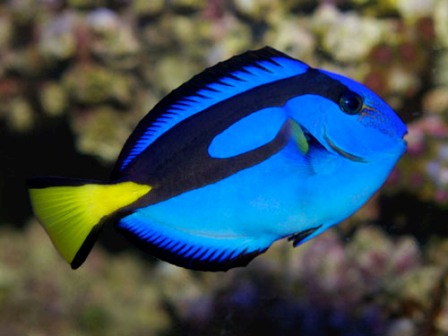
This is often one of the most important phases of adding a new fish species to an existing (or even new) marine aquarium. Sadly, this comprehensive planning is usually relegated to a few moments before the aquarist makes a purchase, as they shuffle across web-sites on their smart-phone, quickly gauging what they’re getting into. An aquarist needs to be certain that the species considered, doesn’t conflict with other life in the tank. For example, it won’t end well if someone adds a surge-zone fish species into a tank full of lagoon loving soft coral species. Something is going to suffer, and sooner or later it will lead to overall instability. In the case of the hippo tang, they do well in what I call a moderate (or average) reef environment. They don’t require intense water current like Achilles tangs prefer, but they do well with a moderate amount of flow.
They are not known to nip corals, so they coexist well with all species of coral, including LPS species on down to soft zooanthid polyps and mushrooms. Once established, hippo tangs can be kept under moderate to high intensity reef lighting. Their primary needs are open swimming spaces and ample hiding spots. Often I see reef tanks, where live rock is crammed along the back wall, creating a miniature wall-drop reef. Corals are growing all over the back-wall, which often rises up nearly to the tank’s water level. A large fish like a hippo tang is left with a buffered left to right swimming area, as often the rock is so dense on the back wall that all swimming area is sealed up, and most hiding spots are too small to accommodate the tang.
This is a stressful situation for a hippo tang, whom is used to hopping from reef to reef, zooming in and out of coral rock and around coral colonies. The fish goes from an exciting reef environment that begs exploration, to a crowded left to right space, void of usable shelter. Hippo tangs often do best, in tanks that employ a design that opens the whole aquarium up to swimming and hiding. For this, tanks that are wide and long work well. A tank that is at least 36” wide, and 48” long can be aquascaped to develop several patches of reef, with open water channels around them. This allows the tang to cruise the channels, and travel from patch to patch. Aquariums of this size are usually very large, often in excess of 200 gallons. This is good for hippo tangs, as they need a tank in excess of 100 gallons to support them into adulthood. However, if an aquarist doesn’t want to maintain that much volume, some tanks (often dubbed shallow reefs or frag flats) have these dimensions, but are only 12-16” high, as opposed to 20-30” high. You get lots of open swimming space, in a tank that is around 150 gallons as opposed to 200 or 300.
The goal is to offer room for open exploration, while also ensuring there are overhangs, nooks and crannies and large crevices, that the tang can slide into when threatened. A proper assessment takes into account the tank’s current occupants. Hippo tangs are peaceful, when compared to other surgeonfish. This is good, as they often don’t pick on fish in the same manner a purple or Sohal tang will, but it does open them up to harassment from belligerent species. Some large marine angelfish will push a hippo tang around, especially when first introduced, and often tangs of other species will as well. Hippo tangs are flighty, and when exposed to consistent stress, they tend to hide and cease feeding. Even still, there are a host of large fish that make good tank mates for them, and in FOWLR tanks grouper and harlequin tuskfish usually leave them alone, as long as the hippo tang is large enough that it cannot be swallowed.
Wrasses, gobies, jaw fish, blennies, mid-water plankton feeding angelfish and a number of other species make good tank mates for a reef housing a hippo tang.
Acclimation:
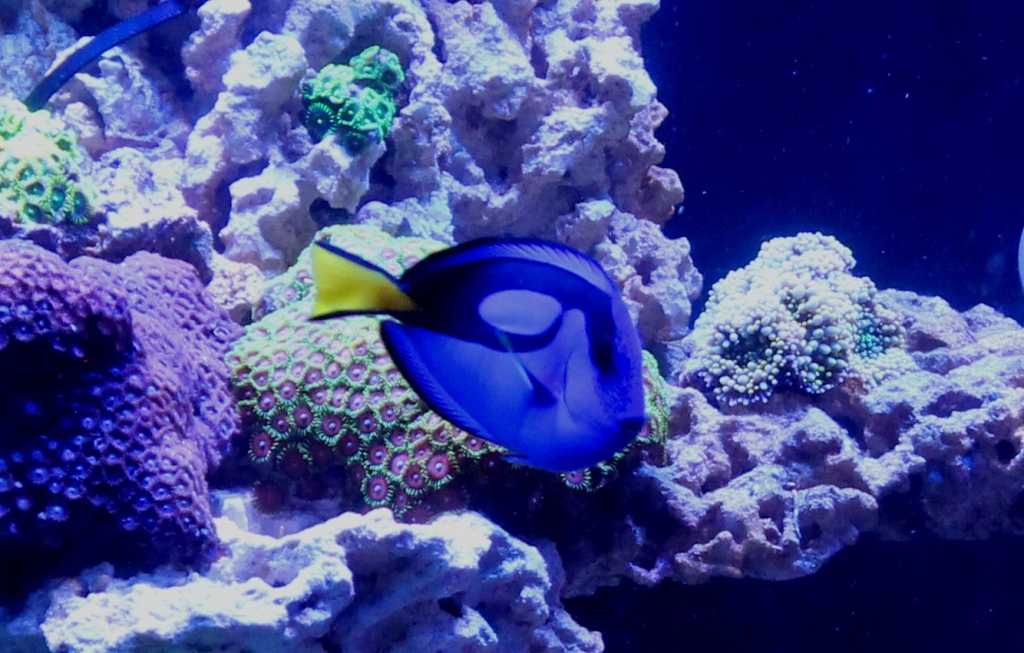
Hippo tangs are notorious ich magnets, and their bright blue and black coloration highlights the parasite so well, that it is unmistakable when they become infected. For this reason, I don’t recommend small, silver dollar sized juvenile fish. When they succumb to ich (and they usually do) their small size allows the parasite to move quickly, and it’s not uncommon to lose them, even when treatment is administered.
It’s best to quarantine a hippo tang (in a tank of 30 or more gallons) under the pretense that it is infected with ich. For this, hypo-salinity works best, as it kills the ich parasite and reduces stress. I recommend a specific gravity of 1.009. The tank should be set at this specific gravity when the fish arrives, and the hippo tang can be acclimation slowly via drip, over the course of 10 hours or more. It’s important to continuously measure salinity in the fish’s acclimation water, while also visually inspecting the fish’s condition. If you notice agitation or stress, reduce the speed of the drip. Considering the length of the drip, I recommend having something generate current (an air-stone/pump works) and a heater in the acclimation tank.
Quarantining a hippo tang isn’t unlike quarantining other marine fish species. The tank can be decorated with clay pots, PVC piping or anything that is inert and doesn’t affect water chemistry. It’s important, even in a hypo-saline quarantine, to closely monitor the fish’s appearance, as it’s possible that an external parasite like velvet can slip through the cracks. Hypo-salinity is incapable of killing velvet, which is a parasitic dinoflagellate. Symptoms include rubbing on tank décor, rapid breathing and general listlessness. The primary symptom is small white spots, gathered in patches over the skin, forming what looks like fuzz. If a suspected velvet infection appears, move quickly. In hypo-salinity, the weapon of choice to eradicate velvet is formalin which can be paired with hypo-salinity safely. Velvet quickly infects the gills, and if not treated immediately often leads to losses.
During quarantine, it’s important to focus on the tang’s diet. Like all surgeonfish, hippo tangs are herbivorous, meaning that they need seaweed available 24/7. I personally use and recommend LRS’s freeze dried seaweed sheets, as they are one of the few available that have lab testing, backing up the manufacturer’s’ nutritional claims. Hippo tangs usually enjoy a lot of meaty fare as well, and a blend such as LRS Reef or Herbivore Frenzy is recommended. Probiotics in either of these diets are believed to aid in proper digestion, and absorption of nutrients. Feeding a blend like this, also saves the hassle and time of supplementing food with Selcon, or additional amino acids, as the food has already been enhanced.
Hippo tangs are hearty eaters, and a healthy fish has a measurable girth through the mid-section. Their laterally compressed bodies make hippo tangs appear thin, when in fact they should be round and thick bodied. A fish that is very thin, with an outline of the spine or other organs showing, is a starving or sick fish.
QT can last 30-45 days or more, depending on how things go throughout the process.
Water quality, tank life:
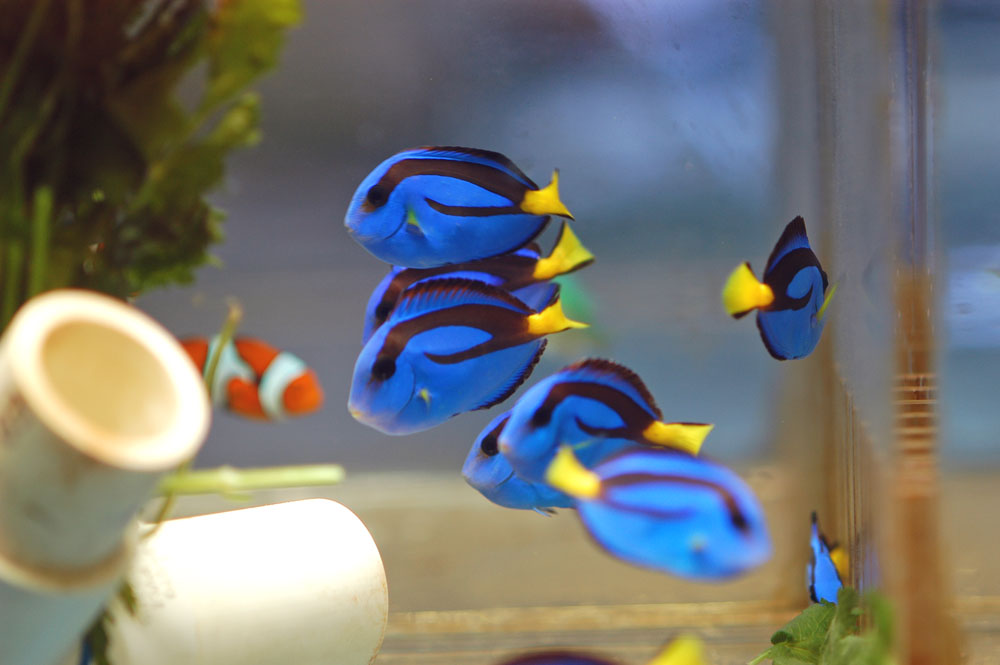
Like all tangs, hippo tangs are sensitive to nutrient load within the water. Phosphate can cause increased stress, cloudy eyes and turn any minor injury into a bacterial/fungal infection. I’ve seen many, many hippo tangs with odd skin infections, usually the product of poor quality water. While most marine fish can tolerate some nitrate within the water, anything in excess of 10 ppm should be addressed. In reality, like most reef animals, hippo tangs do best with as little nitrate present as possible. This poses a unique challenge to the aquarist, as despite their laterally compressed appearance, healthy hippo tangs have strong appetites, and need a constant supply of seaweed. This continuous herbivores’ intake of greens leads to lots of waste being expelled into the water. A strong protein skimmer can remove some of the solid organic waste, but often a microbe (or algae) based de-nitrification system is required, to keep water quality in check.
This can be as simple as a large refugium (roughly 25% the volume of the display tank) or an algae scrubber or reactor. Hippo tangs will often feed on common macro-algae used to purify water, making a scrubber a good choice for both harvesting fresh algae and assimilating nutrients.
Hippo tangs are sleek, powerful swimmers, capable of navigating quickly through the water. While they like a moderate amount of flow, they can become stressed and uneasy if placed in a high flow environment, like those often seen in SPS dominated reef tanks. As was mentioned before, ample hiding spots mixed with open water swimming areas are key components to keeping a hippo tang healthy.
Diet is of special concern when keeping a hippo tang, for several key reasons. One, hippo tangs are susceptible to head and lateral line erosion (HLLE). Diet is implicated as an important part of preventing this disease. Also, as was previously mentioned, hippo tangs are susceptible to a host of external infections, and diet can help support a strong immune system. Selcon is a vitamin/amino acid soak that has been advertised to reverse HLLE. While I’ve never personally seen it reverse the disease, it is a good product to soak frozen and pelleted foods in, before feeding. Foods like LRS’ Reef Frenzy are pre-soaked in nutrition boosting products, saving aquarists the added hassle and expense. Hippo tangs will often accept live (or dead) black worms, which are a nutritious supplement to greens. Also, they often accept ROE or fish eggs, which are considered a highly nutritious food for marine fish. I personally have never had much luck getting hippo tangs to eat pelleted foods with any consistency, and have always relied on frozen foods, or fresh foods I could propagate myself. Obviously algae are important and should always be available.
A note about HLLE:
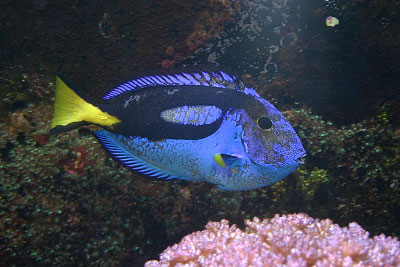
For a new aquarist, HLLE can be a nightmare. It disfigures fish by lining the head and lateral line with tiny pits, which turn colorful flesh bright white and leave behind scar tissue. The main cause is debatable, yet it’s possible wild fish don’t suffer from HLLE. Some believe a parasite is to blame, others blame overstimulation of the lateral line in captivity, while chemical filtration via carbon is also implicated. Personally, I still think the most likely cause is twofold: parasitic infection and nutritional deficiency. For this reason, it’s vital that hippo tangs nutritional needs are met, and luckily new foods on the market provide a mix of rich, human-grade seafood, supplementation with probiotics and infusion of amino-acids and vitamins. This combined with supplemental seaweed feeding, is a good way to maintain a healthy fish and reduce the risk of HLLE.
If you see symptoms of HLLE, as in the formation of pits, I recommend removing the fish from the main display and placing them in a hospital tank. I’ve found a combined hypo-salinity/formalin treatment, without carbon filtration can cease HLLE outbreaks, in the presence of good nutrition. Use of carbon after an infection is up to the individual aquarist, and I recommend weighing the pros and cons and making an informed decision.
Growth and longevity:
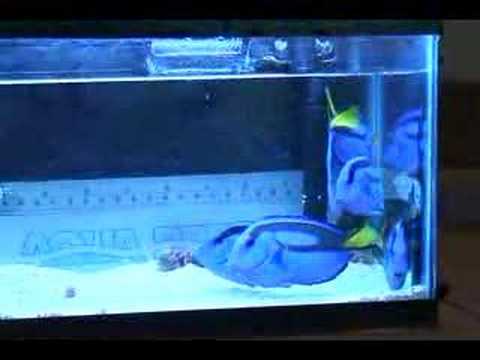
Hippo tangs are neither impossible, nor easy to keep. They are neither huge or small and they are neither extraordinarily difficult to care for, nor extraordinarily easy either. Questions about the fishery that supplies them should cause pause for any responsible aquarist considering getting one, but those who are dedicated to their animals, have some experience caring for surgeonfish and have a large FOWLR or reef tank, may be more than capable of keeping one healthy for years to come.













